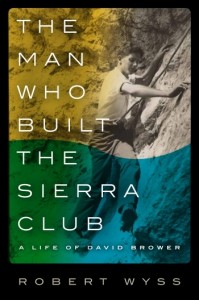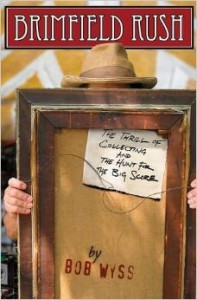Bob Wyss
|
Books |
Periodicals |
Academics |
Service |
Vitae |
The Man Who Built the Sierra Club,
A Life of David Brower,
by Robert Wyss
Hear a Podcast of a Talk about the Book in Seattle here
Author Talks
Upcoming
Greater Hartford Sierra Club, West Hartford Recreation Center, Westmoor Park, 119 Flagg Road, West Hartford, CT 06119
Thursday September 8, 7:30 p.m.
Time Tested Books, 1114 21st Street, Sacramento, CA 95811
Thursday September 22, 7:00 p.m.
Book Passage, 51 Tamal Vista Blvd., Corte Madera, CA 94925
Saturday September 24 1 p.m.
Mansfield Public Library, 54 Warrenville Road, Mansfield Center, CT 06250
October 6, 6:30 p.m.
Peace Dale Public Library, 1057 Kingstown Road, Wakefield, RI 02879
Saturday, October 15 2 p.m.
Saxton B. Little Free Library, 319 CT-87, Columbia, Ct. 06237
Tuesday, November 29 6:30 p.m.
Previously
Tolland Public Library
Wednesday, June 22, 6:30 p.m.
Avon Free Public Library, 281 Country Club Road, Avon, CT 06001
Tuesday, July 26 7 p.m.
Seattle Central Public Library, 1000 4th Ave. Seattle, WA 98014
Tuesday, August 2, 7 p.m.
Third Place Book Store, Ravenna, 6504 20th Ave, NE Seattle, WA 98115
Tuesday, August 9, 7 p.m.
Book Details
Columbia University Press
Release: June 2016
David Brower (1912–2000) was a central figure in the modern environmental movement. His leadership, vision, and elegant conception of the wilderness forever changed how we approach nature. In many ways he was a twentieth-century Thoreau. Brower transformed the Sierra Club into a national force that challenged and stopped federally sponsored projects that would have dammed the Grand Canyon and destroyed hundreds of millions of acres of our nation’s wilderness. To admirers, he was tireless, passionate, visionary, and unyielding. To opponents and even some supporters, he was contentious and polarizing.
As a young man growing up in Berkeley, California, Brower proved himself a fearless climber of the Sierra Nevada’s dangerous peaks. After serving in the U.S. Army’s famed World War II Mountain Division, he became executive director of the Sierra Club. For nearly two decades, Brower led successful efforts to save crucial rivers in the West and millions of acres of wilderness, but in order to block two dams at the Dinosaur National Monument, he compromised on the building of Utah’s Glen Canyon Dam—a loss of wilderness that haunted him until his death.
This uncompromising biography explores every facet of Brower’s time as leader of the Sierra Club and steward of the modern environmental movement. His style inspired many but bordered on reckless. His passionate advocacy destroyed lifelong friendships and at times threatened his goals. Married for fifty-six years, Brower jeopardized everything to engage in affairs with other men. Yet his achievements remain some of the most important triumphs of the conservation movement. What emerges from this unique portrait is a rich and robust profile of a leader who took up the work of John Muir and, along with Rachel Carson, made environmentalism the cause of our time.
Review excerpts:
“Riveting biography” – Library Journal
“Thorough and well researched” Kirkus
Brimfield Rush by Bob Wyss
Excerpts from one reviewer:
If you don’t live in New England or make a practice of frequenting flea markets, you might not be familiar with the name “Brimfield.” It’s not just a small town in south central Massachusetts; it’s become an all-encompassing term (in both noun and verb forms) for the event that overtakes that region three weeks of the year. Author Bob Wyss has provided us with a look at Brimfield’s history as well as the work that goes on behind the scenes. It’s a view we casual visitors don’t usually get or could even guess at. The emphasis here is on the dealers and the residents, and not the average walk-in buyer.
Chapters are arranged in sections chronologically by the flea market weeks: May, July, September, and the following May. Though the book begins with a couple in search of a human skeleton — which they eventually discover and gleefully buy — the focus throughout the text rests on two burgeoning art dealers, Rachel and Joe. Linked in a new professional and personal relationship, they face a number of challenges as they attend Brimfield to buy and sell items for their Pennsylvania art business. Joe is the risk-taker and Rachel the financial manager, and together they struggle to become successful at a work that is fraught with a variety of dilemmas. Should they merely collect, or buy and sell? How much should they reveal to an unsuspecting seller, since “a score has two sides, and for every winner there is a corresponding loser”? (p. 92) What’s real and what is fake? And when will they become comfortable enough to stop moving from show to show and settle down in their own permanent gallery? They find most of their answers by the end of the book.
Covering the Environment, How Journalists Work the Green Beat by Bob Wyss
Covering the Environment serves as a primer for future and current journalists reporting on environmental issues across all types of media. This practical resource explains the primary issues in writing on the environment, identifies who to go to and where to find sources, and offers examples on writing and reporting the beat. It also provides background to help environmental journalists identify their audiences and anticipate reactions to environmental news.
This primer emphasizes the role of environmental journalists not as environmental advocates but as reporters attempting to accurately and fairly report the news. Contents include:
- An overview and history of the environment and journalism, spotlighting the most significant issues in the beat
- Guidance on understanding environmental and health science, ranging from issues of risk, to scientific research and studies, to interviewing scientists
- Insights into government and regulatory communities and environmental advocates on all sides of the political spectrum
- Assistance in accessing public records and conducting computer-assisted reporting
- Guidance in writing the story for print, broadcast and Internet audiences
- An examination of the future of journalism and coverage of the environment.
Observations and story excerpts from experienced journalists provide a “real world” component, illuminating the practice of environmental journalism. Additional features in each chapter include study questions, story assignments and resources for additional information. The book also provides a glossary of environmental, science, regulator and journalism terms, as well as a reference section and index.
This resource has been developed to train advanced undergraduate and graduate journalism students to cover the science and environment community, writing print and broadcast stories to a general audience. It also serves as a guide for working journalists who cover the environment in their work.

